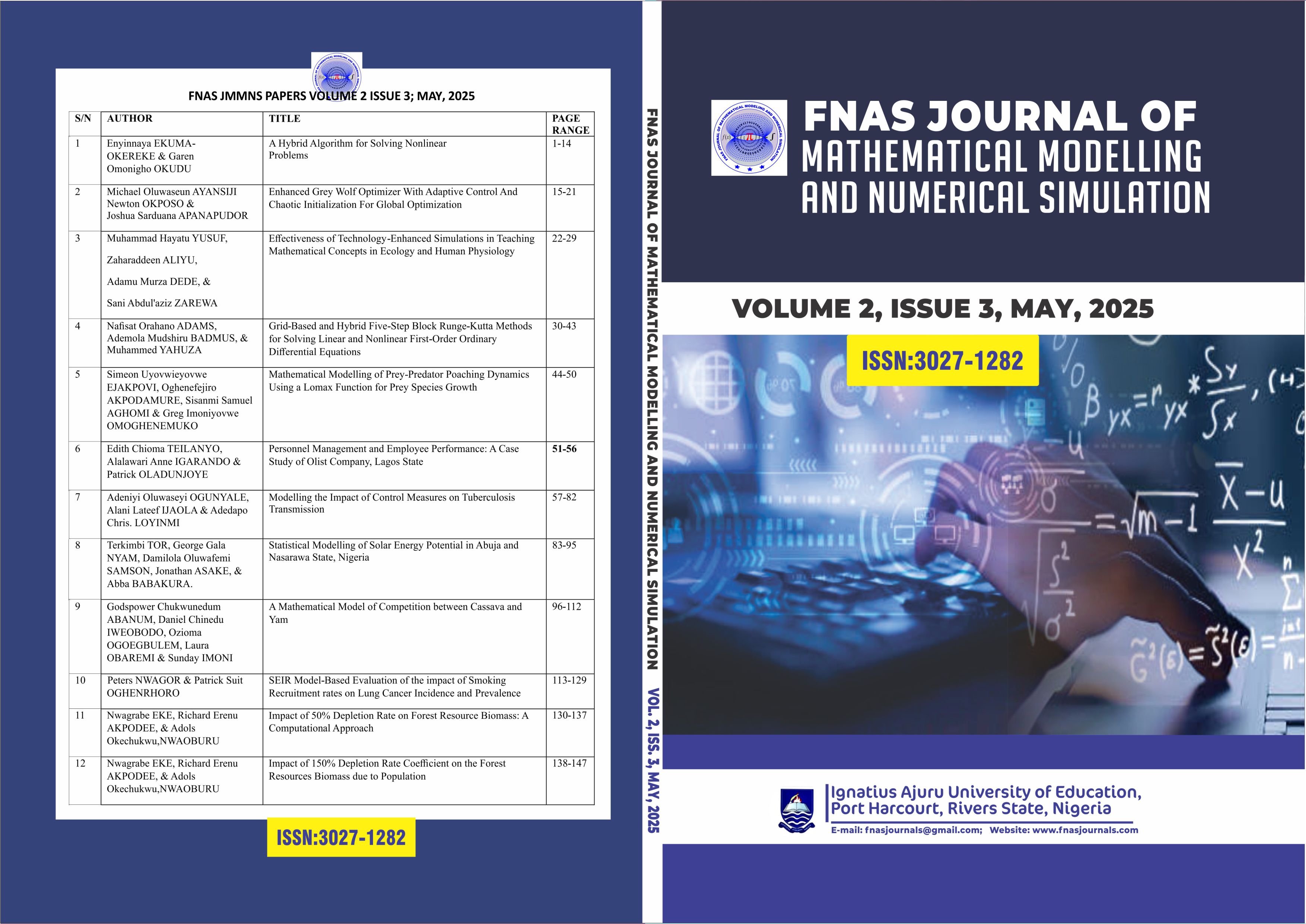Effectiveness of Technology-Enhanced Simulations in Teaching Mathematical Concepts in Ecology and Human Physiology
DOI:
https://doi.org/10.63561/jmns.v2i3.862Keywords:
Technology Enhanced Simulation, Mathematical Concepts, Ecology, Human PhysiologyAbstract
This study examined how well technology-enhanced simulations taught mathematical models in secondary school biology classes that focused on ecology and human physiology. The study examined how virtual simulations can help close the pedagogical gap between abstract mathematical concepts and intricate biological systems. It was based on the Technological Pedagogical Content Knowledge (TPACK) framework, Constructivist Learning Theory, and Cognitive Load Theory. 300 Senior Secondary School Two (SS2) students from six purposefully chosen public schools participated in a quasi-experimental design with a pretest-posttest control group. While the control group was instructed using traditional teacher-led techniques, the experimental group was instructed using AI-supported virtual simulations. Data gathered using the Student Engagement and Comprehension Questionnaire and the Biology-Mathematical Modeling Achievement Test (BMMAT) and the Student Engagement and Comprehension Questionnaire (SECQ) were examined using descriptive and inferential statistics, such as ANCOVA and effect size calculations. The results showed that students in the experimental group performed significantly better than those in the control group in terms of understanding and applying mathematical models in biology, with large effect sizes (Cohen’s d = 1.35 for ecology; 1.49 for physiology) and strong explained variances (Partial Eta² = 0.172 and 0.195). The study also confirmed that simulation-based instruction improves cognitive engagement, lowers unnecessary cognitive load, and supports experiential and collaborative learning. These results are consistent with current research that supports the use of virtual simulations in STEM education to promote interdisciplinary competencies and scientific reasoning, and the study concluded that virtual simulations are transformative pedagogical tools that can increase student engagement and conceptual understanding in biology through dynamic and interactive modeling experiences. It recommends curriculum reforms, teacher professional development, infrastructural investment, AI-driven personalization, and interdisciplinary collaboration to optimize the use of virtual simulations in science education.
References
Almasri, R., Mahmoud, I., & Al Kabi, M. (2022). The effectiveness of computer simulations in teaching biology: An analysis of student engagement and satisfaction. Education and Information Technologies, 27(5), 6523 6542. https://doi.org/10.1007/s10639 022 11017 3 DOI: https://doi.org/10.1007/s10639-022-10940-w
Ayer Miller, D., Lynch, D. J., & Collier, K. N. (2025). Hybrid microbiology education: Virtual simulations paired with in person labs increase student performance and perceptions. Journal of Microbiology & Biology Education, 26(1), e00356 24. https://doi.org/10.1128/jmbe.00356 24 DOI: https://doi.org/10.1128/jmbe.00203-24
Boada, I., López, L., Sanz, S., & Araujo, M. (2024). Teaching mathematical modeling in synthetic biology: A multidisciplinary approach through webinars and guided learning. Education Sciences, 14(2), 134. https://doi.org/10.3390/educsci14020134 DOI: https://doi.org/10.3390/educsci14020134
Çakıroğlu, Ü., Arslan, O., & Yıldız, M. (2024). Enhancing mathematical literacy through virtual reality in mathematics education: An experimental study. Education and Information Technologies, 29(1), 567 589. https://doi.org/10.1007/s10639 023 11735 z
Elazzab, S. (2022). The effect of flipped classroom strategies and virtual simulations on genetic problem solving and future thinking. International Journal of Instruction, 15(1), 321 340. https://doi.org/10.29333/iji.2022.15119a DOI: https://doi.org/10.29333/iji.2022.15119a
Majewska, M., & Vereen, D. (2023). Immersive learning in biology: The impact of virtual reality tools in online science education. Journal of Science Education and Technology, 32(4), 399 415. https://doi.org/10.1007/s10956 023 10059 4
Makransky, G., Terkildsen, T. S., & Mayer, R. E. (2019). Adding immersive virtual reality to a science lab simulation causes more presence but less learning. Learning and Instruction, 60, 225 236. https://doi.org/10.1016/j.learninstruc.2017.12.007 DOI: https://doi.org/10.1016/j.learninstruc.2017.12.007
Mishra, P., & Koehler, M. J. (2006). Technological pedagogical content knowledge: A framework for teacher knowledge. Teachers College Record, 108(6), 1017 1054. https://doi.org/10.1111/j.1467 9620.2006.00684.x DOI: https://doi.org/10.1177/016146810610800610
Navarro, A. M., Fullerton, A. M., & Griffiths, T. L. (2024). Teacher and student perceptions of virtual laboratories in science education: A national study. Journal of STEM Education Research, 7(1), 87 106. https://doi.org/10.1007/s41979 023 00141 5
Pang, J., Lim, K. M., & Ang, K. C. (2025). The effectiveness of virtual simulations in science education: A meta
synthesis of empirical evidence. International Journal of Educational Technology in Higher Education, 22(1), 18. https://doi.org/10.1186/s41239 025 00457 2
Piaget, J. (1970). Science of education and the psychology of the child (D. Coltman, Trans.). Orion Press.
Sweller, J. (1988). Cognitive load during problem solving: Effects on learning. Cognitive Science, 12(2), 257 285. https://doi.org/10.1207/s15516709cog1202_4 DOI: https://doi.org/10.1016/0364-0213(88)90023-7
Tsirulnikov, M., Yaroshevich, M., & Ivankova, T. (2023). The influence of immersive virtual laboratory simulations on student motivation and performance in biochemistry. Biochemistry and Molecular Biology Education, 51(3), 273 280. https://doi.org/10.1002/bmb.21674 DOI: https://doi.org/10.1002/bmb.21674
Vygotsky, L. S. (1978). Mind in society: The development of higher psychological processes. Harvard University Press.


